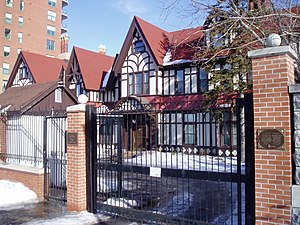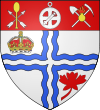This is an old revision of this page, as edited by Good Olfactory (talk | contribs) at 00:11, 11 June 2013 (new key for Category:Attacks on diplomatic missions in Canada: "Turkey" using HotCat). The present address (URL) is a permanent link to this revision, which may differ significantly from the current revision.
Revision as of 00:11, 11 June 2013 by Good Olfactory (talk | contribs) (new key for Category:Attacks on diplomatic missions in Canada: "Turkey" using HotCat)(diff) ← Previous revision | Latest revision (diff) | Newer revision → (diff)| 1985 Turkish embassy attack in Ottawa | |
|---|---|
 | |
| Location | Ottawa, Ontario |
| Coordinates | 45°26′5″N 75°40′32″W / 45.43472°N 75.67556°W / 45.43472; -75.67556 |
| Date | March 12, 1985 7 a.m |
| Target | Turkish Embassy, Ottawa |
| Deaths | 1 |
| Perpetrators | Armenian Revolutionary Army |
The 1985 Turkish embassy attack was an attack on the Turkish embassy in Ottawa, Canada, on March 12, 1985.
The attack
The storming of the embassy began shortly before 7 a.m., when three militants in a rented moving truck arrived at the embassy gate. They scaled the security gate and began shooting at the security hut. The security hut was a bulletproof enclosure guarded by Claude Brunelle, a 31-year-old student from the University of Ottawa, who worked for the private security firm Pinkerton's. As soon as the attack began, Brunelle called in the emergency code to his supervisor and left the bullet-proof enclosure to confront the gunmen. He fired four shots at the gunmen and took two shots in the chest, which killed him instantly.
Using a powerful homemade bomb, the gunmen blasted open the heavy front door of the two-storey, Tudor-style home and embassy office on Wurtemburg Street, in the capital's embassy district about two kilometers east of Parliament Hill. Once inside, they began rounding up hostages, including the wife of the Turkish ambassador, his teen-age daughter and embassy staff members – at least 12 people. Ambassador Coskun Kirca, a veteran career diplomat with United Nations experience, who had been in Canada less than two years, escaped by leaping from the second floor window at the back of the embassy, breaking his right arm, right leg and pelvis.
The police response was almost immediate. Within three minutes, officers were on the scene. Four hours later, the gunmen released all hostages and surrendered – they tossed out their weapons and came out of the building with their hands up, asking only that they not be shot by police. Earlier, in telephone conversations with reporters, they demanded, in exchange for releasing their hostages, that Turkey acknowledge the 1915 Armenian holocaust and “return Armenian lands confiscated by Turkey”. The gunmen, who said they were members of the Armenian Revolutionary Army told Ottawa police they blasted their way into the Turkish embassy “to make Turkey pay for the Armenian genocide" of 1915.
Background
| Part of a series on | ||||||||||||||||||||||||||||||||||||||||
| History of Ottawa | ||||||||||||||||||||||||||||||||||||||||
|---|---|---|---|---|---|---|---|---|---|---|---|---|---|---|---|---|---|---|---|---|---|---|---|---|---|---|---|---|---|---|---|---|---|---|---|---|---|---|---|---|
 | ||||||||||||||||||||||||||||||||||||||||
|
||||||||||||||||||||||||||||||||||||||||
| Timeline | ||||||||||||||||||||||||||||||||||||||||
|
||||||||||||||||||||||||||||||||||||||||
| Historical individuals | ||||||||||||||||||||||||||||||||||||||||
|
| ||||||||||||||||||||||||||||||||||||||||
This was the third assault on Turkish diplomatic personnel in Ottawa by Armenian gunmen in three years: in April 1982, the embassy's commercial counselor – Kani Güngör – was shot and critically injured in a parking garage. The Armenian Secret Army for the Liberation of Armenia quickly took credit for the attack, which left the attaché paralyzed. Four months later, in August 1982, the embassy's military attaché – Col. Atilla Altıkat – was shot to death as he drove to work. The Justice Commandos Against Armenian Genocide claimed responsibility. In addition, other attacks by Armenians on Turkish targets, particularly diplomats, occurred in other countries during 1973-1994.
Indictment and trial
The attackers – Kevork Marachelian, 35, of La Salle, Quebec, Rafi Panos Titizian, 27, of Scarborough, Ontario, and Ohannes Noubarian, 30, of Montreal – were charged with first-degree murder of a security guard during the assault on the Turkish Embassy. They also faced charges of attacking the premises of a diplomat, endangering the life and liberty of Ambassador Coskun Kirca, setting off an explosion to get into the embassy and possessing grenades, handguns and shotguns. Chahe Philippe Arslanian, a lawyer for two of the accused, said that his clients were “not guilty". “It's evident that surely it was not a criminal act, but a political act," Mr. Arslanian told reporters. A year later, on October 14, 1986, the three men went on trial. An Ontario Supreme Court jury deliberated for 8½ hours before finding Mr. Noubarian, Mr. Marachelian, and Mr. Titizian guilty of first-degree murder. Mr. Justice David Watt imposed the mandatory sentence of life imprisonment with no possibility of parole for 25 years.
After the jury gave its verdict and was dismissed, Mr. Noubarian told the court that what the three did "sprang from the national ideals we shared.” “However, something undesirable and regrettable happened and Mr. Brunelle died, resulting in the clouding of our aims and our goals and also resulting in our persecution and trial as simple criminals. But imprisoning individuals would not harm the Armenian cause. Individuals are mortal, but the Armenian nation lives and as long as it lives it will always demand its rights."
In February 2005 the National Parole Board of Canada decided to allow one of the men, Mr. Marachelian, to visit his family for the first time in 20 years. The board granted him two visits over the following six months, during which he had to be accompanied by a corrections officer.
Marachelian and Noubarian were released from prison on February 19, 2010.
Rafi Titizian was also released during April 2010 and sent to Armenia on the day of his release to join his family living in Armenia.
Consequences
The attack on the Turkish Embassy was a major international embarrassment for Canada. For years, foreign diplomats in Ottawa had asked the Canadian government for better security, but to no avail. Turkey declared Ottawa to be one of the most dangerous places in the world for Turkish diplomats. Canada needed a unit that was capable of defeating a determined and well-armed group of militants. This need was ignored until the March 12, 1985 attack on the Turkish Embassy in Ottawa. The event changed the Canadian government's attitude toward militants and set in motion a chain of events that would eventually lead to the creation of Joint Task Force Two.
Claude Brunelle was awarded the Star of Courage for delaying the assailants long enough to allow the Turkish Ambassador to escape.
References
- Deadly embassy attack in Ottawa CBC Archives. March 12, 1985. Accessed 2009-06-11. Archived 2009-06-15.
- ^ Our 'Men in Black' (Part 1). The Ottawa Citizen. February 9, 2002 Saturday Edition, pg. B1 / Front
- ^ "Decorations for Bravery: M. Claude Gerard Brunelle, S.C." Governor General of Canada. 2009-04-30. Archived from the original on 2009-06-15. Retrieved 2009-06-11.
{{cite web}}: Unknown parameter|deadurl=ignored (|url-status=suggested) (help) - ^ Three charged with murder in siege. The Globe and Mail (Canada). March 13, 1985
- World Notes Canada. Time Magazine. Monday, Mar. 25, 1985
- ^ Turks’ Embassy in Ottawa Seized. The New York Times. March 13, 1985, Late City Final Edition. Section A; Page 3, Column 2; Foreign Desk
- Hugh Pope, "Opinion: Turkey and Armenia Inch Forward: Over soccer, the two countries' leaders begin to work on the future instead of getting mired in the past." Los Angeles Times, September 16, 2008.
- ^ 3 go on trial over slaying at embassy. The Globe and Mail (Canada). October 14, 1986. News; Pg. A18
- Raid 'political act': lawyer . The Globe and Mail (Canada). March 13, 1985
- ^ Spectators weep as 3 sentenced to life in Turkish Embassy slaying . The Globe and Mail (Canada). November 1, 1986. News; Pg. A13
- 3 Armenians Convicted In Attack in Ottawa. The New York Times. November 1, 1986, Late City Final Edition. Section 1; Page 5, Column 1; Foreign Desk
- Turkish diplomat survived 1985 embassy siege: Ambassador hurled himself out window during attack by Nick Petter. The Ottawa Citizen, Ontario, Canada. March 7, 2005 Final Edition
- Armenians who occupied Turkish embassy released in Canada. News.az, February 14, 2010
- What Manner of Man by James Ogle, Darnell Bass, 2006. ISBN 1-897113-39-0, ISBN 978-1-897113-39-4. Pg 221
| History |
|
|---|---|
| Geography | |
| Culture | |
| Public services | |
| Education | |
| Government | |
| Transportation and infrastructure | |
| Features | |
- Terrorist incidents in 1985
- Terrorist attacks attributed to Armenian militant groups
- Attacks on diplomatic missions of Turkey
- Justice Commandos of the Armenian Genocide
- 1985 in international relations
- 1985 in Canada
- History of Ottawa
- Canada–Turkey relations
- Murder in 1985
- Attacks on diplomatic missions in Canada